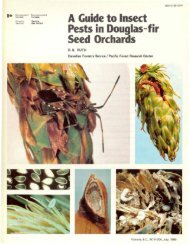the translocation of minerals in trees - Canadian Forest Service
the translocation of minerals in trees - Canadian Forest Service
the translocation of minerals in trees - Canadian Forest Service
Create successful ePaper yourself
Turn your PDF publications into a flip-book with our unique Google optimized e-Paper software.
Calcium45 <strong>in</strong>jected <strong>in</strong>to <strong>the</strong> white p<strong>in</strong>e trunk had a localized distribution<br />
similar to that <strong>of</strong> <strong>the</strong> rubidium86 <strong>in</strong> yellow birch. In <strong>the</strong> white p<strong>in</strong>e trunk <strong>the</strong><br />
isotope moved upwards from <strong>the</strong> po<strong>in</strong>t <strong>of</strong> <strong>in</strong>fection, along a relatively narrow<br />
channel. Only two branches, both with<strong>in</strong> six feet <strong>of</strong> <strong>the</strong> ground, were found to<br />
conta<strong>in</strong> appreciable activity. Monitor<strong>in</strong>g records on August 22, six weeks<br />
after <strong>in</strong>jection, <strong>in</strong>dicated an accumulation <strong>of</strong> calcium <strong>in</strong> <strong>the</strong> ma<strong>in</strong> trunk at a<br />
po<strong>in</strong>t where <strong>the</strong> upper active branch had its orig<strong>in</strong>. From this position <strong>in</strong> <strong>the</strong><br />
trunk, most <strong>of</strong> <strong>the</strong> calcium was carried out <strong>in</strong>to <strong>the</strong> branch. The isotope was<br />
not evenly distributed throughout <strong>the</strong> branch, as <strong>in</strong> any given whorl <strong>of</strong> twigs<br />
some were much more active than o<strong>the</strong>rs.<br />
The <strong>in</strong>ternal distribution <strong>of</strong> <strong>the</strong> calcium was <strong>in</strong>vestigated by autoradiographs.<br />
In this technique (Belanger and Leblond, 1946) sections <strong>of</strong> tissue are coated with<br />
a photographic emulsion and left for different periods <strong>of</strong> exposure rang<strong>in</strong>g from<br />
a few hours to several weeks depend<strong>in</strong>g on <strong>the</strong> degree <strong>of</strong> localization <strong>of</strong> <strong>the</strong><br />
radioisotope and consequent <strong>in</strong>ten ity <strong>of</strong> radiation to which <strong>the</strong> photographic<br />
emulsion <strong>in</strong> contact with <strong>the</strong> section is exposed. The autoradiographs <strong>of</strong> ections<br />
<strong>of</strong> <strong>the</strong> stem (Figure 2) showed activity <strong>in</strong> <strong>the</strong> sieve cells <strong>of</strong> <strong>the</strong> phloem <strong>in</strong> <strong>the</strong><br />
white p<strong>in</strong>e.<br />
Dur<strong>in</strong>g September some <strong>of</strong> <strong>the</strong> calcium45 concentrations had materialized<br />
<strong>in</strong>to visible crystals. Figure 3 shows a cross section <strong>of</strong> crystals <strong>in</strong> <strong>the</strong> phloem<br />
cells. By focus<strong>in</strong>g up on <strong>the</strong> photographic emulsion cover<strong>in</strong>g <strong>the</strong> section <strong>of</strong><br />
<strong>the</strong>se cells, <strong>the</strong> dark dots (Figure 4) represent exposure <strong>of</strong> <strong>the</strong> photographic<br />
emulsion <strong>in</strong>dicat<strong>in</strong>g that <strong>the</strong>se cells conta<strong>in</strong> calcium45•<br />
Presence <strong>of</strong> calcium45 was also noted <strong>in</strong> <strong>the</strong> buds <strong>of</strong> yellow birch. Figure 5a<br />
presents photographs <strong>of</strong> <strong>the</strong> buds, whereas Figure 5b show autoradiographs <strong>of</strong><br />
<strong>the</strong> same buds <strong>in</strong>dicat<strong>in</strong>g <strong>the</strong> presence <strong>of</strong> calcium45 <strong>in</strong> <strong>the</strong> peripheral parts <strong>of</strong><br />
<strong>the</strong>se buds.<br />
Moreland (1950) <strong>in</strong>troduced roots <strong>of</strong> loblolly p<strong>in</strong>e <strong>in</strong>to jars conta<strong>in</strong><strong>in</strong>g<br />
phosphorus32 solution and noted a maximum <strong>translocation</strong> rate <strong>of</strong> more than<br />
four feet per hour.<br />
Yli-Vaakuri (1954) <strong>in</strong> F<strong>in</strong>land showed that movement <strong>of</strong> phosphorus32<br />
would take place from tree to tree and also between <strong>trees</strong> and stumps through<br />
natural root grafts.<br />
Kuntz and Riker (1955) <strong>in</strong> Wiscons<strong>in</strong> studied more extensively <strong>the</strong> use <strong>of</strong><br />
radioisotopes for ascerta<strong>in</strong><strong>in</strong>g <strong>the</strong> role <strong>of</strong> root grafts <strong>in</strong> <strong>the</strong> <strong>translocation</strong> <strong>of</strong><br />
<strong>m<strong>in</strong>erals</strong> between <strong>trees</strong>. Their experiments with iod<strong>in</strong>e131 and rubidium86<br />
<strong>in</strong>cluded <strong>the</strong> <strong>in</strong>sertion <strong>of</strong> cut branches or roots <strong>in</strong>to a bottle conta<strong>in</strong><strong>in</strong>g a radioactive<br />
solution, or <strong>in</strong>jection <strong>of</strong> a solution from a cone or trough similar to <strong>the</strong><br />
technique used by Fraser and Mawson (1953).<br />
The usual rate <strong>of</strong> upward movement <strong>of</strong> <strong>the</strong> isotope <strong>in</strong> <strong>the</strong> <strong>translocation</strong><br />
stream <strong>of</strong> oaks <strong>in</strong> full sunlight and with low relative humidity was between It<br />
and 3 feet per m<strong>in</strong>ute. A limited downward movement <strong>in</strong>to <strong>the</strong> roots was<br />
noticed. Greater movement occurred <strong>in</strong> roots naturally grafted onto those <strong>of</strong><br />
o<strong>the</strong>r <strong>trees</strong>. Radioactivity was detected with<strong>in</strong> 20 m<strong>in</strong>utes <strong>in</strong> most branches,<br />
twigs, and leaves <strong>of</strong> p<strong>in</strong> oak (Quercus ellipsoidalis E. J. Hill) 35 feet high. Radioactivity<br />
appeared only <strong>in</strong> narrow vertical streaks which orig<strong>in</strong>ated at <strong>the</strong> chisel<br />
cuts, and <strong>in</strong> certa<strong>in</strong> branches <strong>of</strong> <strong>the</strong> bur oak (Quercus macro carp a Michx.).<br />
The diffuse movement <strong>of</strong> <strong>the</strong> isotopes throughout trunks and <strong>the</strong> crown <strong>of</strong> <strong>the</strong><br />
nor<strong>the</strong>rn p<strong>in</strong> oak was quite different from <strong>the</strong> limited l<strong>in</strong>ear flow <strong>in</strong> <strong>the</strong> trunk and<br />
certa<strong>in</strong> branches <strong>of</strong> <strong>the</strong> bur oak. In this respect <strong>the</strong> bur oak behaved like <strong>the</strong><br />
yellow birch and white p<strong>in</strong>e <strong>in</strong> <strong>the</strong> experiments by Fraser and Mawson (1953).<br />
Movement <strong>of</strong> <strong>the</strong> isotopes was reduced by very low light <strong>in</strong>tensities, free moisture<br />
on <strong>the</strong> leaves, and absence <strong>of</strong> functional leaves. Little movement occurred<br />
dur<strong>in</strong>g <strong>the</strong> dormant period. When dom<strong>in</strong>ant and suppressed <strong>trees</strong> were connected<br />
by root grafts, isotopes moved both ways but most commonly from <strong>the</strong><br />
11


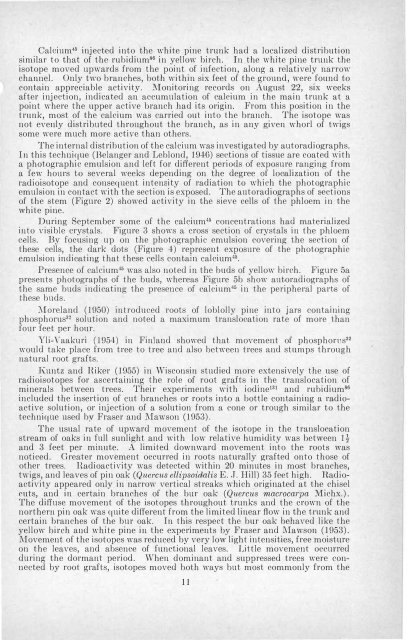
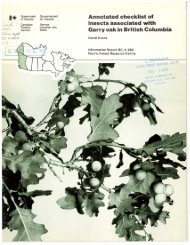
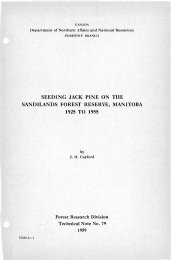
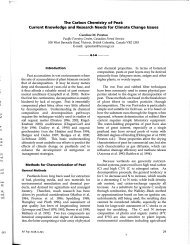


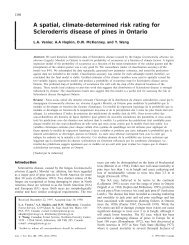

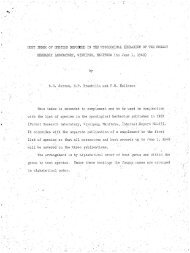
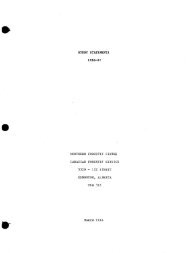
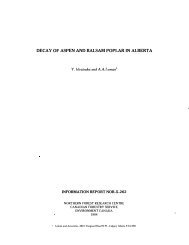
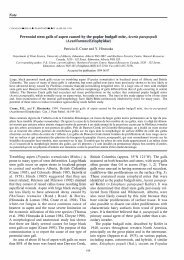
![Po],rell](https://img.yumpu.com/11946277/1/190x231/porell.jpg?quality=85)
